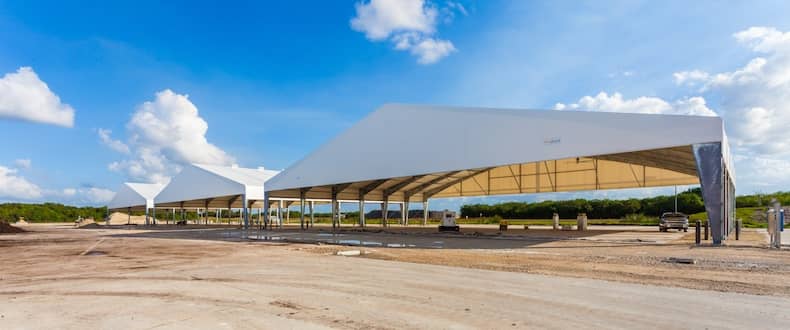 When constructing a fabric building, many engineers, building owners and project managers come down to two choices—products based on polyethylene and those developed using polyvinyl chloride (PVC) coated Polyester Fabrics.
When constructing a fabric building, many engineers, building owners and project managers come down to two choices—products based on polyethylene and those developed using polyvinyl chloride (PVC) coated Polyester Fabrics.
Selecting the right choice for your product depends on your priorities, the environment of the building and other considerations.
Most structure fabric materials are durable and able to work for many types of buildings when manufactured, inspected, and installed correctly. At a glance, Polyethylene products have many similarities to PVC/Polyester products, but the PVC/Polyester fabrics offer some key advantages.
Set Your Priorities
Given the similarities, one might think that either option is the same, but Polyethylene and PVC/Polyester fabrics vary in some key ways.
- Lifespan - Look for a product with a significant warranty. Many fabric buildings can last more than 20 years (or 30 for PVC fabric) with little maintenance. Find a provider that can show long-term success with similar projects in similar environments.
- Cost - Look at lifetime costs, factoring in warranties and the provider’s record for customer service and support. As the gold standard, PVC/Polyester fabric costs more initially but often outperforms due to a long, trouble-free life.
- Colors - Some providers can offer a wide range of colors or color-matching services. If color matters, select a provider that can meet your needs. Because of the manufacturing process, it is easier to make custom colored PVC/Polyester fabric in short production runs.
- Light transmittance – Both Polyethylene and PVC/Polyester fabrics can be produced in translucent versions; higher light transmission can be reached with the polyethylene material but at a shorter life expectancy.
- Strength - Particularly if your building is facing challenging weather conditions, look for a product with superior tensile strength. PVC/Polyester fabrics are a standout here; they are able to be made at 2 or 3 times the tensile strength of the polyethylene materials.
- UV resistance - UV rays break down all polymer coatings over time. Selecting the most UV-resistant materials will generally provide the longest lasting structure membrane. PVC/Polyester membranes can be formulated to provide 20 plus years of UV resistance.
- Flame resistance - All products must meet certain standards for fire resistance. PVC fabric generally performs best, as it is naturally flame-retardant and self-extinguishes.
- Deployment - Polyethylene is not designed for multiple folds, and can only be deployed once. If your structure is temporary, this is a key consideration.
- Repairability - In general, PVC is easier to repair.
There is no simple answer to the perfect fabric for your job. Consult with experienced professionals who have worked extensively with structural fabric. They will make recommendations based on your specific needs. To learn more about architectural fabric options, contact Shelter-Rite.

